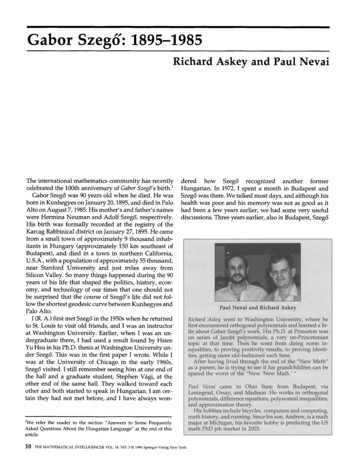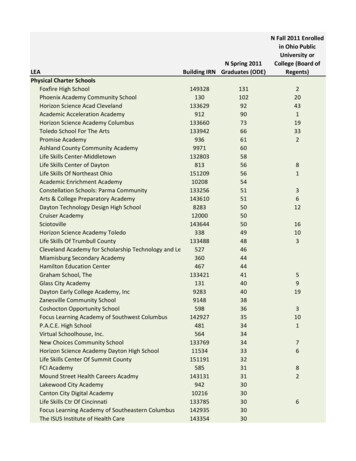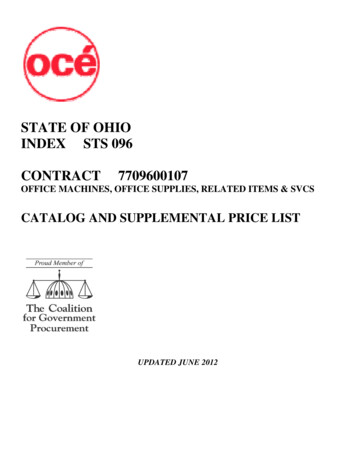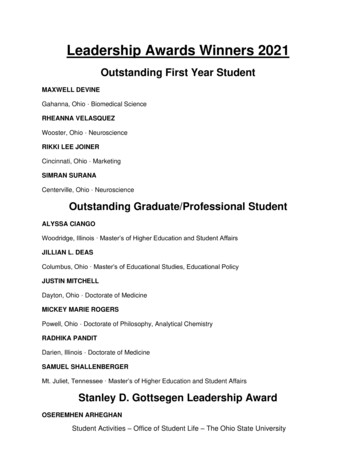
Transcription
Gabor Szeg6": 1895-1985Richard Askey and Paul NevaiThe international mathematics community has recentlycelebrated the 100th anniversary of Gabor SzegS"s birth. 1Gabor Szeg6 was 90 years old when he died. He wasborn in Kunhegyes on January 20,1895, and died in PaloAlto on August 7, 1985. His mother's and father's nameswere Hermina Neuman and Adolf Szeg6, respectively.His birth was formally recorded at the registry of theKarcag Rabbinical district on January 27, 1895. He camefrom a small town of approximately 9 thousand inhabitants in Hungary (approximately 150 km southeast ofBudapest), and died in a town in northern California,U.S.A., with a population of approximately 55 thousand,near Stanford University and just miles away fromSilicon Valley. So many things happened during the 90years of his life that shaped the politics, history, economy, and technology of our times that one should notbe surprised that the course of Szeg6's life did not follow the shortest geodesic curve between Kunhegyes andPalo Alto.I (R. A.) first met Szeg6 in the 1950s when he returnedto St. Louis to visit old friends, and I was an instructorat Washington University. Earlier, when I was an undergraduate there, I had used a result found by HsienYu Hsu in his Ph.D. thesis at Washington University under Szeg6. This was in the first paper I wrote. While Iwas at the University of Chicago in the early 1960s,Szeg6 visited. I still remember seeing him at one end ofthe hall and a graduate student, Stephen V gi, at theother end of the same hall. They walked toward eachother and both started to speak in Hungarian. I am certain they had not met before, and I have always won-dered how Szeg6 recognized another formerHungarian. In 1972, I spent a month in Budapest andSzeg6 was there. We talked most days, and although hishealth was poor and his memory was not as good as ithad been a few years earlier, we had some very usefuldiscussions. Three years earlier, also in Budapest, Szeg61We refer the reader to the section " A n s w e r s to Some FrequentlyAsked Questions A b o u t the H u n g a r i a n Language" at the end of thisarticle.10THE MATHEMATICALINTELLIGENCERVOL. 18, NO. 3 9 1996 Springer-VerlagNew York
Adolf Szeg6 (father of Gabor Szeg6).had mentioned two papers of his which he said shouldbe studied. I did not do it immediately, but three monthslater I did. One contained the solution of a problem Ihad been trying to solve for three years. His paper hadbeen written 40 years earlier. I learned from this thatGabor Szeg6 in 1896 (age around 18 months).Hermina Neuman Szeg6 (mother of Gabor Szeg6).when a great mathematician tells you to look at a paperwhich he or she thinks has been unjustly neglected, oneshould do it rapidly.I (P. N.) only met Szeg6 once. It was in 1972 when Ihad just graduated. By that time, he had been inactivein mathematics research for almost a decade. Yet he wasthe mathematician who, for two reasons, had the greatest influence on my career as a research mathematician.One of the reasons was the book which we calledP61ya-SzegG that is, the problem book titled ProblemsandTheorems in Analysis by George P61ya and Szeg6 whichneeds no introduction for the readers of this article. Theother reason was the book SzegG that is, Szeg6's monograph titled Orthogonal Polynomials and the accompanying contemporary theory of orthogonal polynomials,whose founding father was Szeg6. To be really pedantic, he should be called the "founding grandfather,"since it is already the third generation of mathematicians who is developing his theory today. These bookswill be discussed later in more detail. Very recently, Ihad an extraordinarily rewarding experience whileworking on a project which led to erecting Szeg6's bustin Kunhegyes, St. Louis, and Stanford.THE MATHEMATICAL INTELLIGENCER VOL. 18, NO. 3, 199611
In telegraphic style: Gabor Szeg6 was ProfessorEmeritus at Stanford University. He was a member ofthe American Academy of Arts and Sciences, the ScienceAcademy of Vienna, and the Hungarian Academy ofSciences. He was one of the prominent classical analystsof the twentieth century. He wrote more than 130 research articles and authored or co-authored 4 influential books, 2 of which were exceptionally successful. Foranalysts, Szeg6 is best known for Szeg6"s extremal problem, for his results on Toeplitz matrices which led to theconcept of the Szeg6"reproducing kernel and which werethe starting point for the Szeg6" limit theorem and thestrong Szeg6"limit theorem, and for SzegS"s theory of Szeg 'sorthogonal polynomials on the unit circle. These have beensummarized in his books Orthogonal Polynomials(ColloquiumPublications,Vol.23, AmericanMathematical Society, Providence, RI, 1939) and ToeplitzForms and Their Applications (jointly with Ulf Grenander,University of California Press, Berkeley and LosAngeles, 1958). The former is one of the most successful books ever published by the American MathematicalSociety (four editions and numerous reprints). The bookAufgaben und Lehrsdtze aus der Analysis, vols. I and II("Problems and Theorems in Analysis"), which he coauthored with George P61ya in 1925, contributed to theeducation of many generations of mathematicians. Itwas first published by Springer-Verlag in the seriesGrundlehren der mathematischen Wissenschaften inEinzeldarstellungen mit besonderer Berucksichtigungder Anwendungsgebiete (widely known as TheGrundlehren) as volumes 19 and 20. The bookIsoperimetric Inequalities in Mathematical Physics by P61yaand Szeg6 was published as No. 27 in the series Annalsof Mathematical Studies by Princeton University Press,Princeton, NJ in 1951 (translated into Russian in 1962).Lawrence E. Payne writes on p. 39 of Vol. 1 of Szeg6'sCollected Papers (Birkhauser, 1982): "Not only did this[book] make available to the mathematical public anumber of powerful new tools of mathematical investigation but it also opened up an interesting new and fertile area of mathematical research." His work and results not only deeply influenced the development ofpure and applied mathematics but also found many applications in statistics, physics, chemistry, and variousfields of engineering science.In what follows, we discuss Szeg6's life and work, asseen by us and by several of his contemporaries.After completing elementary school in Kunhegyesand graduating from high school in Szolnok (a town approximately 100 km southeast of Budapest) on June 28,1912, he enrolled in the P zm ny P6ter University inBudapest (today known as E6tv6s L6r nd University),where he primarily studied mathematics and physics.The same year, he won first prize in the academic contest organized by the (Hungarian) Mathematical andPhysical Society (which later became known as theE6tv6s Competition and today is known as the12THE MATHEMATICAL INTELLIGENCER VOL. 18, NO. 3, 1996Ki rsch k Competition). Winning the competition wasmuch more than a passing event but rather a very important milestone in Szeg6's career. The competition, asall mathematically inclined Hungarians know, carried agreat deal of prestige. It was especially important forSzeg6 because it is doubtful that, as a Jew whose family had no connections, he would have been able without it to study or receive the attention that he did. Hisfather had even tried to discourage him from enteringthe university since he thought that his son would haveno future there as a Jew. Szeg6 later made sure his children knew of these circumstances. The following year,his paper on polynomial approximations of continuousfunctions received a University prize. He never abandoned approximation theory, and his very last researchpaper also focused on this subject.Szeg6 spent the summers of 1913 and 1914 inGermany, first at the University of Berlin, later at theUniversity of G6ttingen. In Berlin, he attended the lectures of Georg Ferdinand Frobenius, HermannAmandus Schwarz, and Konrad Knopp, and he alsoparticipated in Friedrich Schottky's seminar. InG6ttingen, he took courses from David Hilbert, EdmundLandau, and a fellow Hungarian, Alfr6d Haar, who wasteaching there at the time.When the First World War broke out, he immediatelyreturned to Hungary and continued his university studies there until May 15, 1915. Conscription was underw a y and he knew that he would be drafted into the armyof the Austro-Hungarian Monarchy. So, to avoid the infantry, he bought a horse and enlisted in the cavalry.According to his comments to his children, he was apoor horseman and fared poorly. He spent the last yearsof the war in Vienna. His military service lasted beyondthe Austro-Hungarian capitulation on November 11,1918; he remained in the army until early 1919. Duringthis time, he served in the infantry, the artillery, and theair force. Naturally, the military applications of aero-To avoid the infantry, he bought a horse and enlisted in the cavalry.nautics were not very sophisticated at that time.However, the Austro-Hungarian Air Force had two extraordinary theoretical experts, Theodore von K irm nand Richard von Mises, two of the founders of modernaerodynamics. They both became Szeg6's lifelongfriends.Between 1912 and 1915, Leopold Fej6r, Man6 Beke,J6zsef K6rsch k, and Mih ly Bauer were among his professors. He met George P61ya (who, at the age of 97,died in Palo Alto on September 7, 1985) and MihMyFekete (of transfinite diameter fame) at this time; Szeg6developed a long-lasting collaboration with both ofthem.His first publication in an international journal, in
which he gave a solution of a problem p r o p o s e d byP61ya, was in Archiv der Mathematik und Physik 21 (1913),291-292. As w e k n o w very well, there are problems atvarious levels. Some, like those done in school, everyone should learn h o w to do. Then there are contest problems, like those in the Mathematical Olympiads. Thesefrequently require d e e p e r insight than seems indicatedat first reading. The problem of P61ya, which Szeg6solved and published in 1913, is an example of a stillharder type, which attracts prospective mathematicians.H u n g a r y has long specialized in the use of problems toattract y o u n g students to mathematics; other countrieshave learned from them, and have contests of problemsto encourage d e e p e r mathematical thought.His first research paper, "Ein G r e n z w e r t s a t z / i b e r dieToeplitzschen Determinanten einer reellen positivenFunktion," was published in the Mathematische Annalen76 (1915), 490-503. This is h o w P61ya r e m e m b e r s it in1982 (p. 11 of Vol. 1 of Szeg6's Collected Papers):Our cooperation started from a conjecture which I found. Itwas about a determinant considered by Toeplitz and others, formed with the Fourier-coefficients of a function fix).I had no proof, but I published the conjecture and the youngSzeg6 found the proof [.] We have seen here a good example of the fruitful cooperation between two mathematicians. Mathematical theorems often, perhaps in most cases,are found in two steps: first the guess is found; then minutes, or hours, or days, or weeks, or months, perhaps evenseveral years later, the proof is found. Now the two stepscan be done by different mathematicians, as we have seen.Szeg6 spent another 45 years working on sharpening,extending, and finding applications of the results published in this article, and the t h e o r y of Toeplitz determinants became one of his p r i m a r y research areas.While he was serving in the military and his unit wasstationed in Vienna, he received his Ph.D. from theUniversity of Vienna on July 8, 1918. His dissertationwas based on the above-mentioned article. Fifty yearslater, he returned to Vienna for a celebration of this, andI (R. A.) still r e m e m b e r h o w pleased he was recallingthis celebration in conversation a few years later.Szeg6, having been a mathematical p r o d i g y himself,was an ideal person to be asked to tutor one of the greatmathematical minds of this century, John v o n N e u m a n n(born as J nos N e u m a n n in Budapest in 1903). Here iswhat N o r m a n Macrae wrote in his book John vonNeumann (Pantheon Books, N e w York, 1992, p. 702)Professor Joseph Kiirsch k soon wrote to a university tutor,Gabriel Szeg6, saying that the Lutheran School had a youngboy of quite extraordinary talent. Would Szeg6, as was theHungarian tradition with infant prodigies, give some university teaching to the lad?Szeg6's own account of what happened was modest. Hewrote that he went to the von Neumann house once or twicea week, had tea, discussed set theory, the theory of measurement, and some other subjects with Jancsi [Johnny inHungarian], and set him some problems. Other accounts inBudapest were more dramatic. Mrs. Szeg6 recalled that herhusband came home with tears in his eyes from his first encounter with the young prodigy. The brilliant solutions tothe problems posed by Szeg6, written by Johnny on the stationery of his father's bank, can still be seen in the vonNeumann archives in Budapest.Szeg6 was married on M a y 22, 1919, in Budapest justafter he was released from the A u s t r o - H u n g a r i a n Army.His wife, Erzs6bet Anna Nem6nyi, had a Ph.D. in chemistry from the P zm ny P6ter University in Budapest.H e was still in uniform w h e n they were married. It isGabor Szeg6, his wife Anna, and their children, Peter andVeronica, shortly after their arrival in the U.S. in 1934.2According to Macrae, the "coaching" took place in 1915-16, but mostlikely it was earlier. Macrae writes that yon Neumann entered theLutheran School in Budapest and that "L szl6 R itz [was an] instructor in mathematics in Johnny's 1914-21." Then he writes that "R tz'srecognition of von Neumann's mathematical talents was instant [.]R tz turned his student over to the mathematicians at BudapestUniversity." This would suggest that the tutoring started in late 1914.On the other hand, Veronica Szego Tincher gathers from her father'scomments that the tutoring occurred after the First World War", although it is also possible that their mathematical discussions beganbefore the War."THE MATHEMATICALINTELLIGENCERVOL.18, NO. 3, 1996 13
said that during the ceremony, there was bombing froma boat on the Danube. They were to have two children:Peter (born in Berlin in 1925) and Veronica (born inK6nigsberg in 1929). Peter is an engineer by profession;he wrote a number of papers on special functions. Helives in San Jose where he is retired from work with theState Legislature of California. Veronica has lived inSouthern California since 1954 and worked for theUniversity of Southern California. She retired in 1995 asExecutive Director for Budget and Planning and nowlives in Palo Alto. Veronica has three children, Steven,Emily, and Russell. Emily has a son, Nathan, and Russellhas a daughter, Micaela.The Szeg6s lived in a happy marriage until Anna, after many years of suffering, died in 1968. Subsequently,Gabor married Ir6n Vajda in 1972 in Budapest. She diedin 1982 in Budapest.Turbulent revolutionary, counterrevolutionary, andanti-semitically discriminatory years followed the FirstWorld War (in political terms: Mih ly K rolyi middle, B61a Kun left, and Mikl6s Horthy right). Therewere only a very limited number of academic positionsin Hungary. As a result, a great many Hungarian scientists who were not appreciated or were even labeledas unreliable characters in their own country, leftHungary, primarily for Germany, Switzerland, theUnited Kingdom, and a decade or so later, for the UnitedStates, where they received much more scientific and financial respect and reward than they could ever hopefor in Hungary. For a short while, Szeg6 worked as anassistant of J6zsef K/irsch k at the Technical Universityof Budapest in 1919 and 1920. After he could no longerwork at the university, John von Neumann's fatherMaximilian helped Szeg6.Giving up all hope that he would ever get a job guaranteeing a reasonable living in Hungary, he moved toBerlin in 1921, where he became a friend and colleagueof Issai Schur and worked with Leon Lichtenstein, vonMises, and Erhard Schmidt. For a result on the equiconvergence of orthogonal polynomial series and trigonometric Fourier series, he received his Habilitation in1921. With this, he became a Privatdozent at theUniversity of Berlin in May 1921. This meant that he hadthe right to give lectures but received very little compensation for it. Other mathematicians holding this title at the University of Berlin in the 1920s were StefanBergman, Salomon Bochner, Eberhard Hopf, HeinzHopf, Charles Loewner, 3 and von Neumann.From 1925 he had the Lehrstuhl fiir angewandteMathematik (chair for applied mathematics). This was acalled Karl L6wner in those days. In 1984 Louis de Brangesproved the Bieberbach conjecture, the most famous previously unsolved problem in classical complexanalysis, utilizing, in addition tothe results of Milin-Lebedev and Askey-Gasper, the works ofLoewner from those Berlin years.3He w a s14THE MATHEMATICAL INTELLIGENCER VOL, 18, NO. 3, 1996nichtbeamtete ausserordentliche Professur, that is, an associate professorship without tenure. When Szeg6 leftBerlin, Adolf Hammerstein (1888-1941) became his successor and held this position from 1927 to 1935. Szeg6'sabove-mentioned paper was published in theMathematische Zeitschrifi 12 (1922), 61-94. At the sametime, independently from Szeg6, his Berlin colleaguesBergman and Bochner laid d o w n the foundations of atheory of orthogonal functions that approached theproblem from a different perspective. During this period, Szeg6 was also helping Lichtenstein with editingthe Jahrbuch fiber die Fortschritte der Mathematik.While in Berlin, he was awarded the Julius K6nigprize by the E6tv6s L6r nd Mathematical and PhysicalSociety on April 10,1924. The members of the prize committee were J6zsef Kfirschak (president), Gyula Farkas,D6nes K6nig, and Frederick Riesz. F. Riesz was askedto make a presentation report on the work of the recip-.ient. His report was published in Hungarian inMathematikai ds Physikai Lapok 23 (1924), 1-6, and later itThe two volume P61ya-Szeg6" is the best writtenand most useful problem book in the history ofmathematics.was reprinted (pp. 1461-1466) with a French translation(pp. 1573-1576) in the second volume of F. Riesz'sOeuvres Completes (Akad6miai Kiad6, Budapest, 1960).We recommend it highly: an English translation is provided at the end of this article.There is general consensus among mathematiciansthat the two-volume P61ya-Szeg6" is the best written andmost useful problem book in the history of mathematics. In the 70 years since its first publication, it has continuously influenced mathematics research and made agreat impact on the education and training of youngmathematicians. So far, it has had four German, oneEnglish, one Hungarian, and three Russian editions.Both authors believed that mathematics could only belearned by doing mathematics. The book introduces thereader to mathematical research through a series of carefully selected and related problems, in such a w a y thatafter analyzing and solving a group of these problems,the reader is almost ready to do independent researchin that particular area. Even though the title suggeststhat the book is about analysis and most of the problems were indeed selected from that area, a variety ofproblems from number theory, combinatorics, andgeometry were also included, along with a few physical applications. The selection of the problems demonstrates the refined taste and mathematical elegance ofthe authors as well as their technical repertoire.Virtually every page offers something unexpected--anelegant argument, an unexpectedly clever proof, or asingle problem that grows into a complex theory right
in front of one's eyes. P61ya describes the origins ofP61ya-Szeg6" (p. 11 of Vol. 1 of Szeg6's Collected Papers);I cannot remember how and when the plan emerged; whatis certain is that we worked on this plan for many years until the work appeared in two volumes in 1925.It was a wonderful time; we worked with enthusiasm andconcentration. We had similar backgrounds. We were bothinfluenced, like all other Hungarian mathematicians of thattime, by Leopold Fej6r. We were both readers of the samewell directed Hungarian Mathematical Journal for highschool students that stressed problem solving. We were interested in the same kind of questions, in the same topics;but one of us knew more about one topic and the other moreabout some other topic. It was a fine collaboration. The book[P61ya-Szeg6"],the result of our cooperation, is my best workand also the best work of Gabor Szeg6.It is hardto arguewithP61ya's assessmentofPdlya-SzegS. T h e y set a standard for later books of problems, and no one has yet come close to their level. Szeg6was always m o d e s t w h e n he talked of this collaboration. H e e m p h a s i z e d that the idea and the planningcame from P61ya, and cooperative efforts followed.Szeg6 was invited to the University of K6nigsberg tosucceed K n o p p in 1926 and w o r k e d there as Ordinarius(Professor) until 1934. His first two Ph.D. students werein K6nigsberg. One of his favorite stories is related toHilbert's visit to the city in 1930. Hilbert was to be givenan " h o n o n a r y citizenship" b y the city of K6nigsberg. Hehad not come dressed for the exceptionally cold fallweather. Szeg6 helped Hilbert out b y lending him anovercoat so that his native city could w e l c o m e him.Life became increasingly difficult for Jews inG e r m a n y in the 1930s. Szeg6 was one of the last to suffer, because he was so highly respected b y his studentsand colleagues and because of his service in the FirstWorld War. This is w h a t P61ya wrote to Jacob DavidTamarkin from Z6rich dated February 14, 1934:It was very difficult to write about the chief point which isthe fate of Szeg6. Well, I shall be brief and plain. I am terribly worried about him. I saw Mrs. Szeg6 in December. Igot a letter from Szeg6 in the beginning of January; althoughno official measure was taken against him [until the beginning of January] and no direct collision happened with thestudents, I cannot see how it would go on indefinitely under those circumstances. He would accept, I understand,any offer even for a short period of I or 2 years, he shouldtry to get a leave of absence for that time, and see whetherhe can live with his family on that amount. There is no hopeto get something for him in Hungary, say Fej6r and alsoSzeg6 himself [.] I could not do anything for him here inSwitzerland [.] Excuse this letter, but you see, I am worried. The whole European situation is very dark.Tamarkin set to w o r k immediately, trying to find a jobfor Szeg6 in the United States (cf. p. 2 of Vol. I of Szeg6'sCollected Papers). Obviously, such a task was not simplein the middle thirties during the Great Depression; itwas next to impossible even for American mathematicians to find jobs. Most positions involved a consider-able a m o u n t of teaching (12 hours a week was not at allexceptional, and there were cases w h e n it was evenmore) and were poorly paid ( 3000 a year was considered a good salary). It is less widely k n o w n that Jewswere not particularly welcome in the United States during the 1930s either. United States officials were seemingly not interested in p r o v i d i n g asylum. Aided b y theunrelenting support of some American mathematicians,quite a few Jewish mathematicians m a n a g e d to come,and this played a major role in the d e v e l o p m e n t of mathematics in the United States. For a better u n d e r s t a n d i n gof the period, w e suggest several articles published inA Century of Mathematics in America, Part I (Peter Duren,ed., American Mathematical Society, 1988); in particular, "The European mathematicians' migration toAmerica" b y Lipman Bers (pp. 231-243) and "Refugeemathematicians in the United States of America,1933-1941: Reception and reaction" by N a t h a n Reingold(pp. 175-200).In M a y 1934, during his Pentecostal holidays, Szeg6w e n t to C o p e n h a g e n to confer with Harald Bohr abouthis future. Without having to w o r r y about G e r m a n censors, he used this o p p o r t u n i t y to write a letter, datedM a y 23, 1934, to Tamarkin. The b a c k g r o u n d was this.In 1925, Szeg6 had been invited for a visiting appointment to D a r t m o u t h College. The Szeg6s considered itcarefully but decided to turn it d o w n because his futureseemed more secure in Germany. Szeg6 then recomm e n d e d Tamarkin for the position. It is thus not surprising that Szeg6 t u r n e d to Tamarkin for assistance;they continued to be close friends until Tamarkin'sdeath in 1945. Szeg6's letter to Tamarkin was written inGerman; it is reprinted on pp. 3-6 of Vol. 1 of Szeg6'sCollected Papers.In this letter, he describes his feelings about the futureof his family and his contemporaries. He seems u n a w a r eof h o w serious the situation was. In reality, it was theirlives that were at risk. (According to Carl de Boor, w h otranslated the letter for us, Szeg6's German style was excellent and it would be hard to recapture it in English.)Copenhagen, 23. May 1934Dear Mr. Tamarkin!For some time now, I have been planning to write to youand thank you, respectively Professor Richardson, most cordially for all the efforts you have made on my behalf. Pleaseforgive the fact that, once again, I write in German, I can inthis way express myself partly more easily, partly more precisely. I do hope that the reading of this letter will not bedifficult for you because of the language.I have come to Copenhagen for a few days over thePentecost break. I will tell you in a moment what made memake this journey. However, in the interest of clarity, I wantto begin with a short description of my situation, startingroughly at the point last summer when we last corresponded concerning these questions. Since that time, therehas been, on the face of it, no essential change in my personal situation. I have been treated, by colleagues as wellTHE MATHEMATICAL INTELLIGENCER VOL. 18, NO. 3, 199615
as students, correctly and, despite the present political passions, bearably. Nevertheless, m y situation continues naturally to be very difficult, in many instances very depressingand offensive. At the center of these difficulties stands theworry about m y family, especially the education and futureof m y children. In order keep him a w a y from the politicsfilled air of the school and the life in Germany, we have, already last fall, sent our nine-year old b o y to Switzerland,where he is well taken care of, body and soul. Since a fewdays ago, he is with us during summer vacation, giving usthe opportunity to see clearly the great advantage of his staythere. However, this situation cannot be maintained forlong . . . . The future of our children is hard to visualize inGermany. This, I am convinced, w o u l d be the case even if,against expectations, there were to be a change in the general direction taken b y the government . . . .A d d e d to these considerations concerning the presentand future of m y children is the point that I have no faithat all in the stability of m y own situation. Last summer, wehad many discussions with Fej6r about these matters, considered parallels to the analogous (as w e saw it) development in Hungary, etc. Some of the prophesies have alreadybeen contradicted b y what has happened. In Germany, thecourse of the new 'Weltanschauung' is being maintainedwith such single-mindedness that a change, a compromise,or even an attenuation in the near future cannot be expected.Of course, there are shades and differences of temperamentin the leading circle, and it is impossible to predict whichforces will finally be victorious. For example, in the recentformation of the "Reichskultusministerium' [Ministry forCulture] (a change which is of prime importance for personnel questions at the universities), the better spirit seemsto have come out on top. Yet, one still hears reassurancesthat in 5 years no 'non-Aryan' person will occupy a university chair. I point to the m a n y retirements that have takenplace recently, often without any p r o p e r procedure (e.g.,Rademacher, at the end of February of this year), also to retirements for the sake of administrative simplification, butwith the hidden goal to remove u n w a n t e d persons who otherwise w o u l d be protected by the 'Beamtengesetz' ['Law forthe Restoration of the German Civil Service']. Just a fewweeks ago, an outstanding classical philologist has in thisw a y been removed from m y university. In Mathematics, thesituation in K6nigsberg is as follows. Reidemeister has beenmoved, and no successor has so far been appointed. Thismeans that I a m needed for the time being since I am alone ina position of responsibility. However, as soon as the successor arrives, something to be expected rather sooner than later(probably by the fall), I don't expect to stay around muchlonger, even though, as a participant in the war and officerat the front, I s u p p o s e d l y am not affected b y that bill. Lastsummer, it was generally thought that this 'Beamtengesetz'would be temporary in any case, so sooner or later the [former] law-based security would be restored. Since then, thebill has been extended twice already, and there is nothing toprevent further extensions ad inf. In addition, should the billbe revoked, there remain a thousand other means for making it impossible to w o r k here. Such bills are changed withmuch greater ease than, say, a mathematician w o u l d switchfrom one system of axioms to another.One other pertinent fact deserves to be stressed. K6nigsberg has been called, semiofficially, a 'Reichsuniversit/it',meaning that in future only politically correct people willwork there. It is therefore nearly impossible that I will remain there after the final arrangements have been made,probably this coming fall, as a consequence of the formation of the Reichskultusmi
THE MATHEMATICAL INTELLIGENCER VOL. 18, NO. 3, 1996 11 . In telegraphic style: Gabor Szeg6 was Professor Emeritus at Stanford University. He was a member of the American Academy of Arts and Sciences, the Science Academy of Vienna, and the Hungarian Academy of Sci










